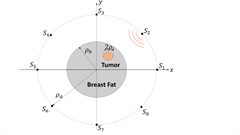Microwave hyperthermia can either be used as a sole treatment method for breast cancer or it can be utilized as a complementary treatment technique to enhance the effectiveness of main treatment methods such as chemotherapy. During both hyperthermia treatment approaches, the temperature produced within the breast medium via deposition of microwave power is not monitored. To this end, this project aims to produce a portable mild breast cancer hyperthermia system prototype equipped with a microwave imaging sub-system for non-invasive monitoring the temperature within the breast medium during the application of the microwave hyperthermia. Towards this goal, we developed,
- a linear hyperthermia system along with a machine learning based antenna phase determination method,
- a circular hyperthermia system with iterative antenna phase determination,
- a deep learning aided microwave imaging-based temperature monitoring method for detection of thermal anomalies,
- and finally, microwave imaging method for thermal mapping of the breast.
The Linear system and circular system configurations are shown in Figure 1. We obtained successful results while implementing novel methods for both microwave hyperthermia and imaging systems. To the best our knowledge, this project is the first to implement microwave imaging for thermal monitoring along with deep learning for phase optimization and for thermal anomaly detection. Our results are now published/accepted/under review in multiple journals including Scientific Reports, Diagnostics, IEEE Access, IEEE Transactions on Antennas and Propagation, IEEE Transactions on Microwave Theory and Techniques.
|

|

|

|
|
(a)
|
(b)
|
(c)
|
|
Figure 1. Configurations of linear and circular systems (a) linear hyperthermia system configuration, (b) linear hyperthermia system prototype, (c) circular hyperthermia system configuration.
|
Outputs:
- Acar, Burak, Tuba Yilmaz, Ali Yapar. 2021. "A Simple and Robust Antenna Phase Optimization Scheme for Microwave Energy Focusing in Breast Cancer Hyperthermia Treatment" IEEE Transactions on Antennas and Propagation. (Under Review)
- Acar, Burak, Tuba Yilmaz, Ali Yapar. 2021. " Microwave Energy Focusing Scheme for Breast Cancer Hyperthermia Treatment with Realistic Breasts Phantoms" IEEE Transactions on Antennas and Propagation. (Under Review)
- Girgin, Enes,Hulusi Önal, Tuba Yilmaz, Mehmet Nuri Akıncı. 2021.‘A Real-time Breast Cancer Hyperthermia Monitoring Scheme Based on Processing of Microwave Scattering Parameters with Deep Learning ‘ IEEE Access. (Under Review)
- Önal, Hulusi, Tuba Yilmaz, Mehmet Nuri Akıncı. 2021.‘Inverse Scattering Based Heat Mapping for Hyperthermia Monitoring ‘ IEEE Transactions on Antennas and Propagation. IEEE Access. (Under Review)
- Aysa Jafarifarmand, Tuba Yilmaz, Ibrahim Akduman, ‘Antenna Configuration and Frequency of Operation Optimization with Neural Networks for Microwave Medical Diagnostic Systems.’ IEEE Transactions on Microwave Theory and Techniques. (Under Review)
- Cemanur Aydınalp, Sulayman Joof, Mehmet Nuri Akıncı, Ibrahim Akduman, and Tuba Yilmaz, ‘Microwave Dielectric Property Retrieval from Open-Ended Coaxial Probe Response with Deep Learning.’ IEEE Access. (Accepted for publication)
- Emre Onemli, Sulayman Joof, Cemanur Aydinalp, Sultan Onemli, Nural Pastaci Ozsobaci, Fatma Ates Alkan, Nuray Kepil, Islem Rekik, Ibrahim Akduman, and Tuba Yilmaz, ‘Classification of Rat Mammary Carcinoma with Large Scale In vivo Microwave Measurements.’ Scientific Reports. (Accepted for publication)
- Altintas, Gulsah, Ibrahim Akduman, Aleksandar Janjic, and Tuba Yilmaz. 2021. "A Novel Approach on Microwave Hyperthermia" Diagnostics 11, no. 3: 493.
- Tuba Yilmaz, "Multiclass Classification of Hepatic Anomalies with Dielectric Properties: From Phantom Materials to Rat Hepatic Tissues." Sensors, vol. 20, no. 2, pp. 530, 2020.
- Cemanur Aydinalp, Sulayman Joof, Tuba Yilmaz, " Towards Accurate Microwave Characterization of Tissues: Sensing Depth Analysis of Open-Ended Coaxial Probes with Ex Vivo Rat Breast and Skin Tissues" Diagnostics, vol.11, no. 2: 338, 2021.